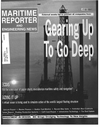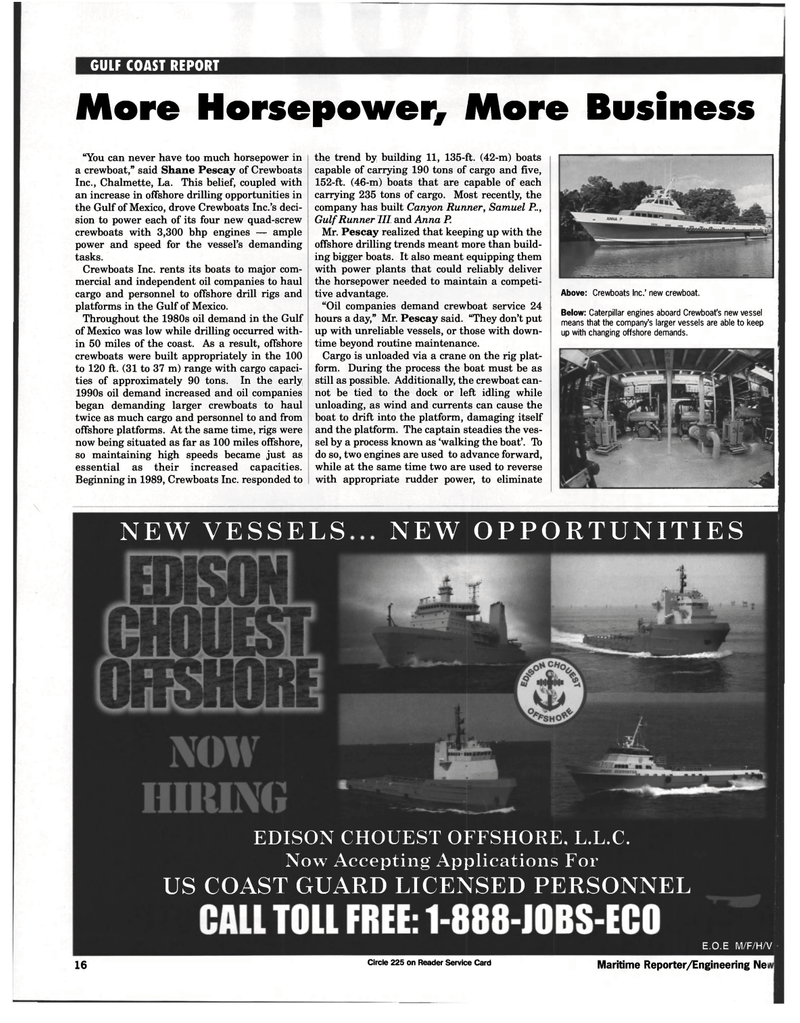
Page 16: of Maritime Reporter Magazine (April 1998)
Read this page in Pdf, Flash or Html5 edition of April 1998 Maritime Reporter Magazine
GULF COAST REPORT
More Horsepower, More Business "You can never have too much horsepower in a crewboat," said Shane Pescay of Crewboats
Inc., Chalmette, La. This belief, coupled with an increase in offshore drilling opportunities in the Gulf of Mexico, drove Crewboats Inc.'s deci- sion to power each of its four new quad-screw crewboats with 3,300 bhp engines — ample power and speed for the vessel's demanding tasks.
Crewboats Inc. rents its boats to major com- mercial and independent oil companies to haul cargo and personnel to offshore drill rigs and platforms in the Gulf of Mexico.
Throughout the 1980s oil demand in the Gulf of Mexico was low while drilling occurred with- in 50 miles of the coast. As a result, offshore crewboats were built appropriately in the 100 to 120 ft. (31 to 37 m) range with cargo capaci- ties of approximately 90 tons. In the early 1990s oil demand increased and oil companies began demanding larger crewboats to haul twice as much cargo and personnel to and from offshore platforms. At the same time, rigs were now being situated as far as 100 miles offshore, so maintaining high speeds became just as essential as their increased capacities.
Beginning in 1989, Crewboats Inc. responded to the trend by building 11, 135-ft. (42-m) boats capable of carrying 190 tons of cargo and five, 152-ft. (46-m) boats that are capable of each carrying 235 tons of cargo. Most recently, the company has built Canyon Runner, Samuel P.,
Gulf Runner III and Anna P.
Mr. Pescay realized that keeping up with the offshore drilling trends meant more than build- ing bigger boats. It also meant equipping them with power plants that could reliably deliver the horsepower needed to maintain a competi- tive advantage. "Oil companies demand crewboat service 24 hours a day," Mr. Pescay said. "They don't put up with unreliable vessels, or those with down- time beyond routine maintenance.
Cargo is unloaded via a crane on the rig plat- form. During the process the boat must be as still as possible. Additionally, the crewboat can- not be tied to the dock or left idling while unloading, as wind and currents can cause the boat to drift into the platform, damaging itself and the platform. The captain steadies the ves- sel by a process known as 'walking the boat'. To do so, two engines are used to advance forward, while at the same time two are used to reverse with appropriate rudder power, to eliminate
Above: Crewboats Inc.' new crewboat.
Below: Caterpillar engines aboard Crewboat's new vessel means that the company's larger vessels are able to keep up with changing offshore demands.
NEW OPPORTUNITIES NEW VESSELS
EDISON CHOUEST OFFSHORE, L.L.C.
Now Accepting Applications For
US COAST GUARD LICENSED PERSONNEL
E.O.E M/F/H/V 16 Circ,e 225 on Reader Service C3* Maritime Reporter/Engineering Ne

 15
15

 17
17
